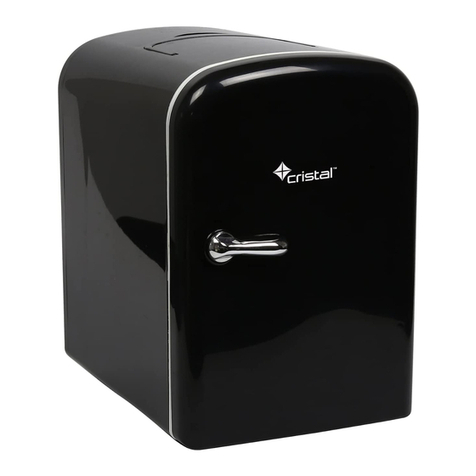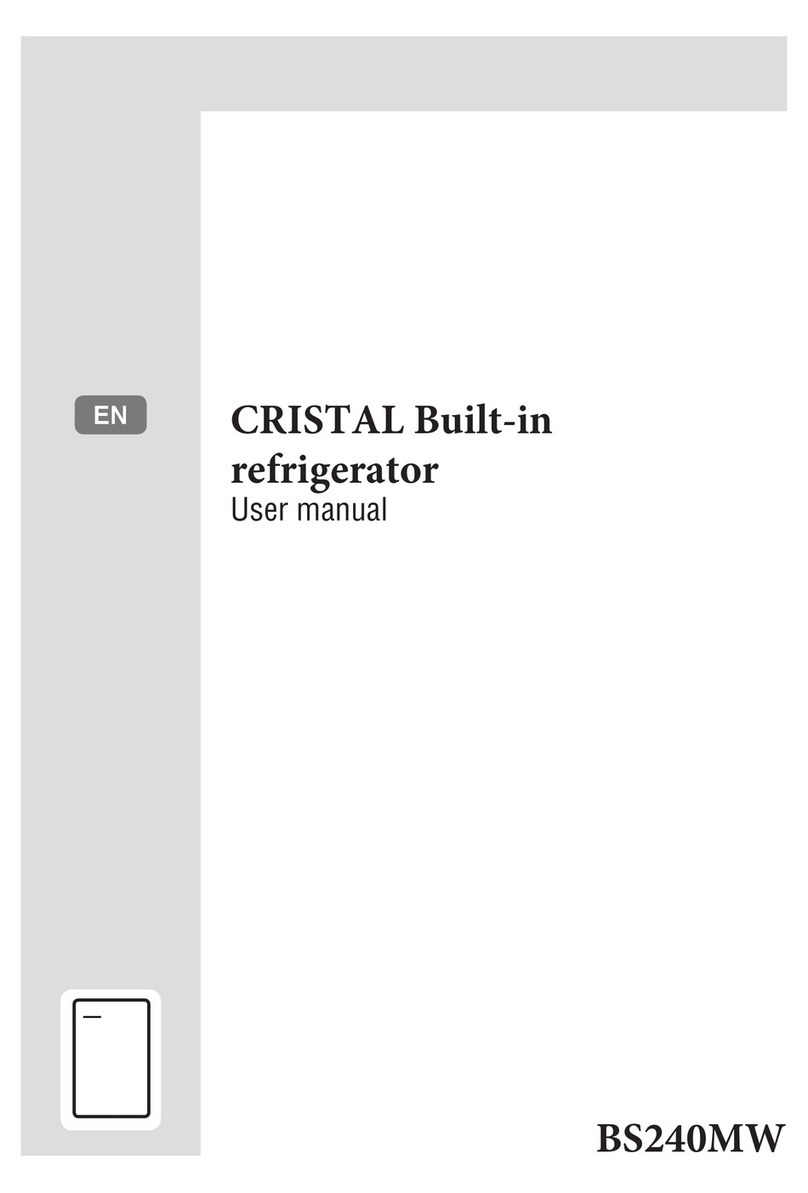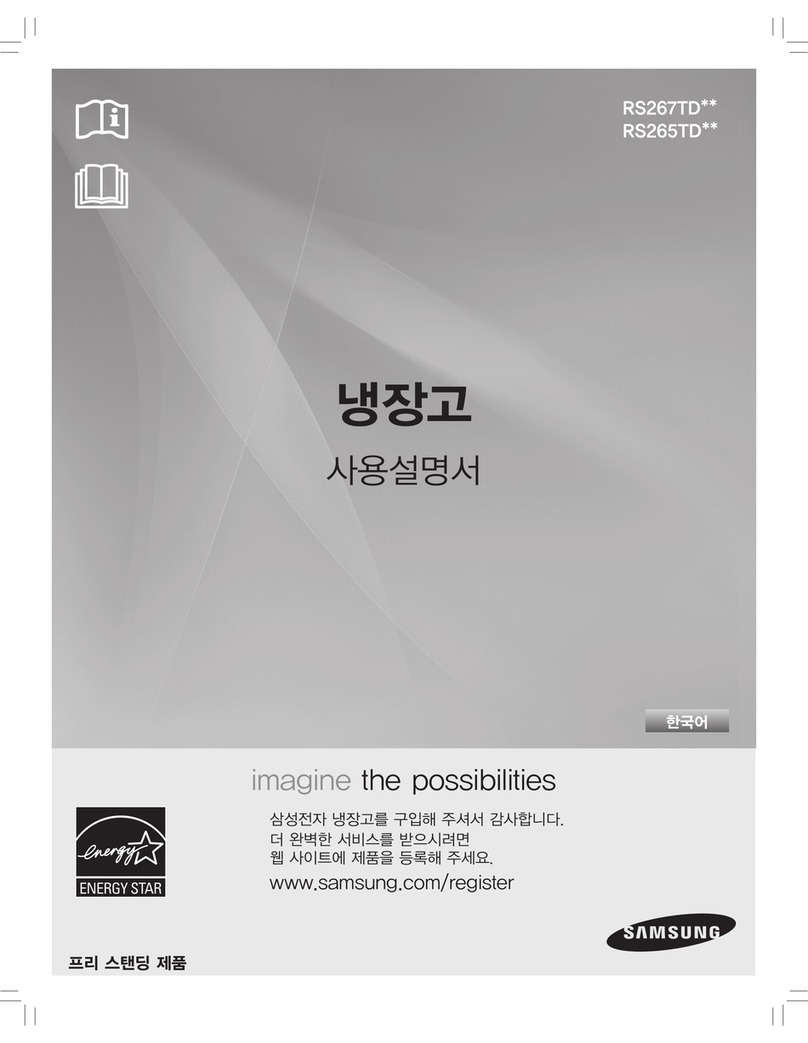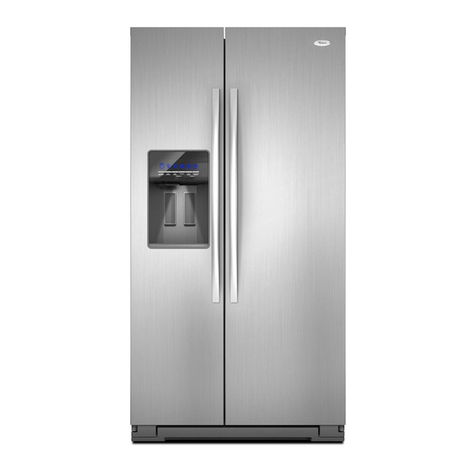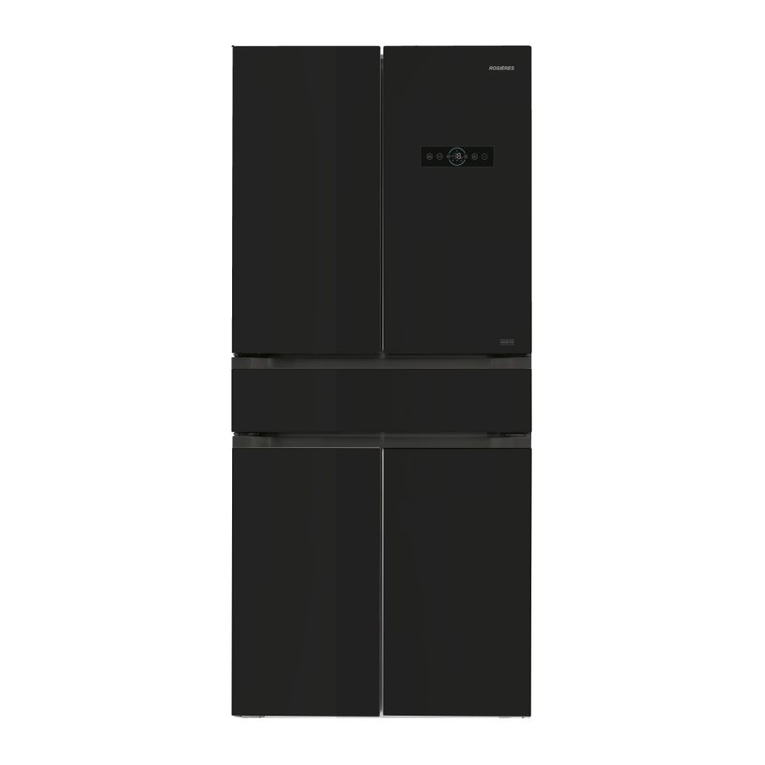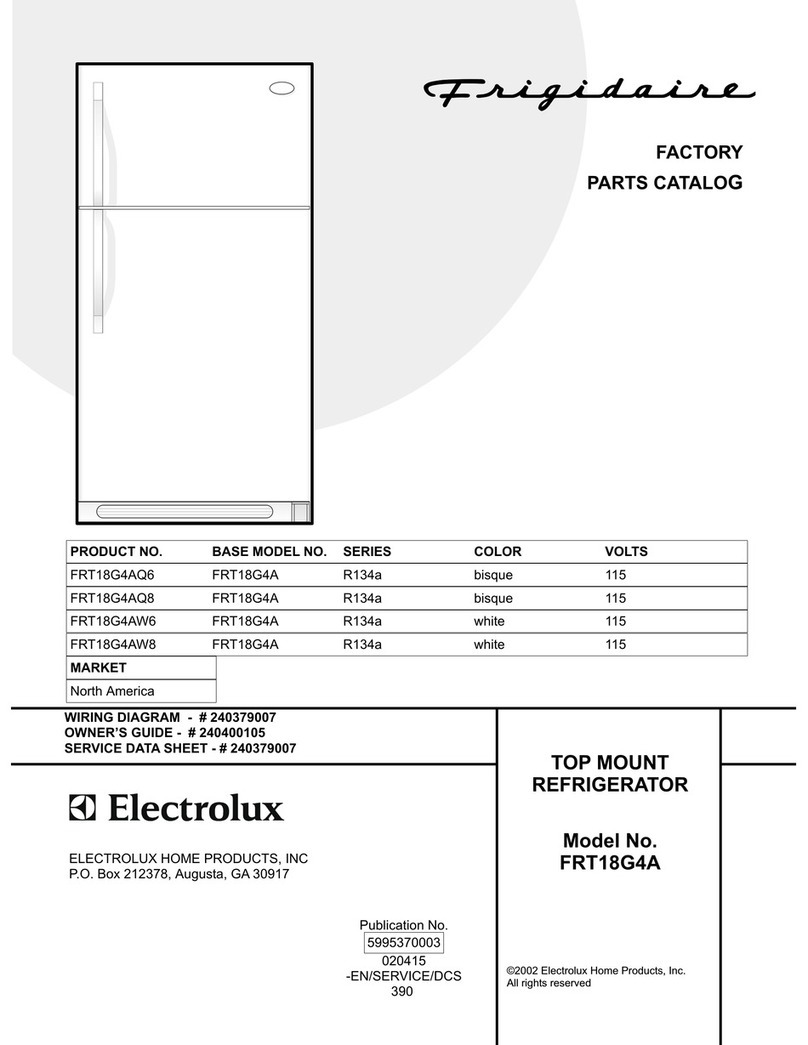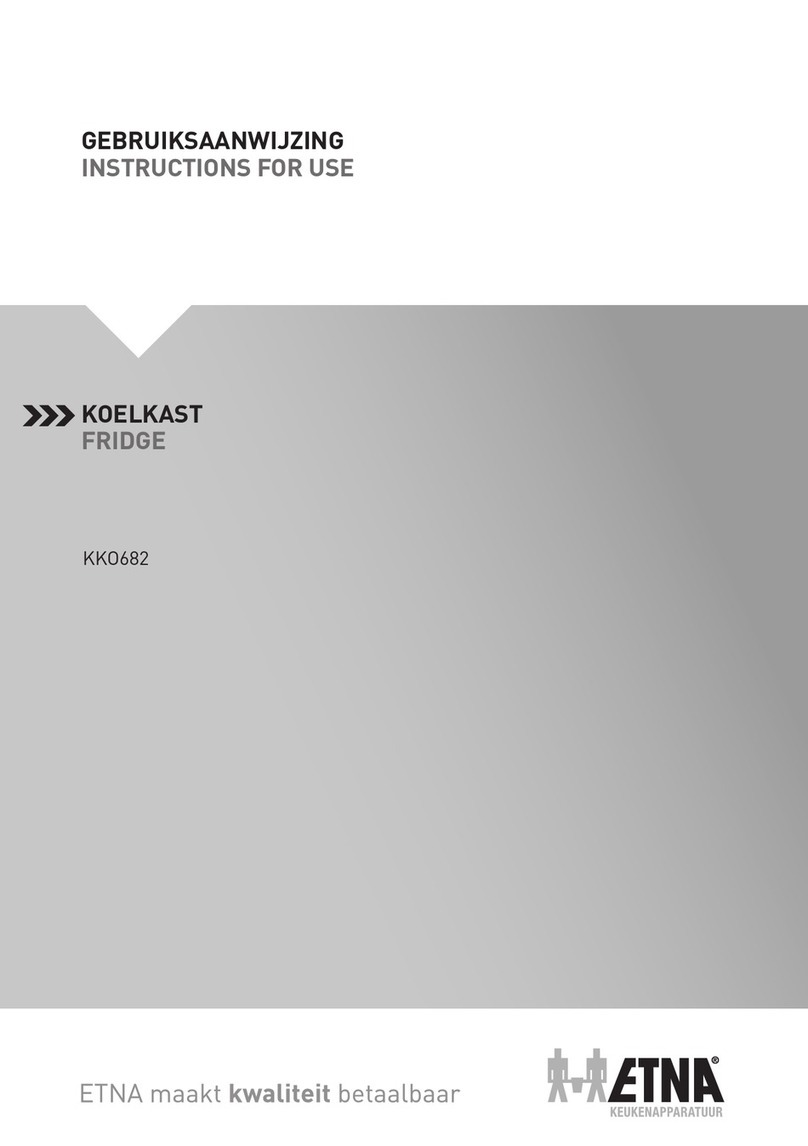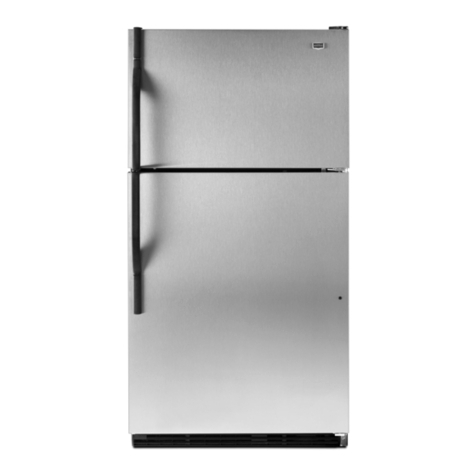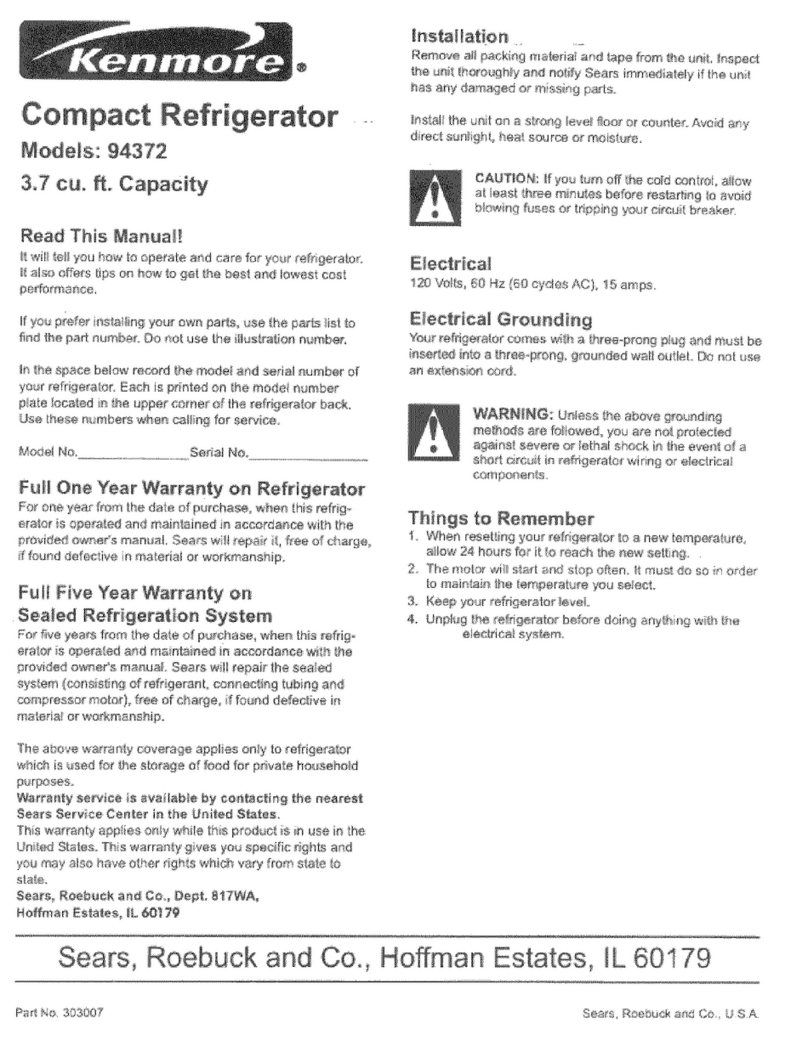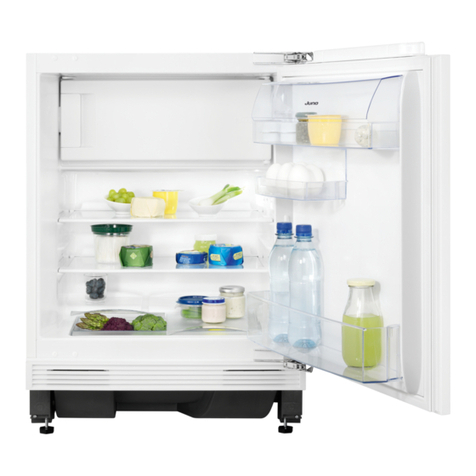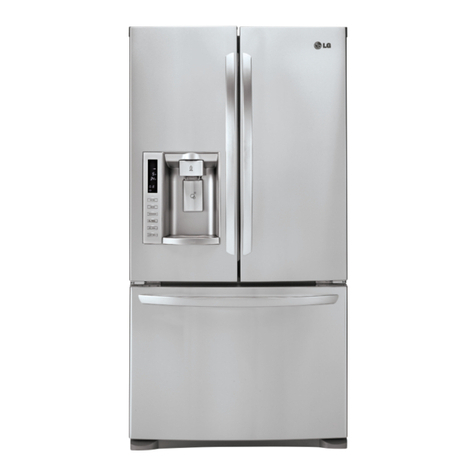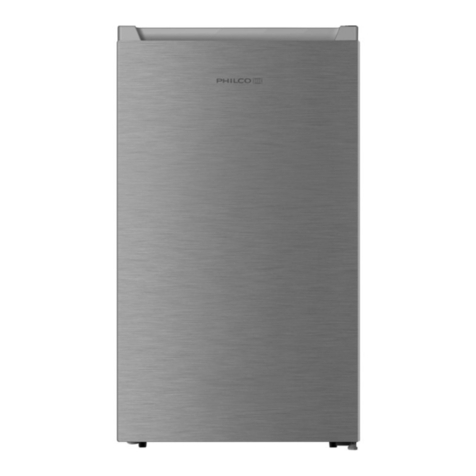CRISTAL BS216EW User manual

EN BUILT IN REFRIGERATOR
Fridge - Freezer
User manual
BS216EW
TR ANKASTRE BUZDOLABI
Kullanma kılavuzu

EN - 2 -
Contents
INSTRUCTIONS PREALABLES ............................................................... 3
General warnings ........................................................................................3
Old and out-of-order fridges ........................................................................5
Safety warnings ...........................................................................................5
Installing and operating your fridge .............................................................6
Before Using your Fridge.............................................................................6
Electrical connection (For UK type plug) .....................................................7
How to wire a 13 amp plug.........................................................................................7
HOW TO OPERATE THE APPLIANCE..................................................... 8
Information on the Frost Free Technology...................................................8
Thermostat Setting ......................................................................................9
Warnings about Temperature Adjustments..................................................9
Accessories ...............................................................................................10
Ice tray .....................................................................................................................10
Bottle holder (In some models) ................................................................................10
FOOD STORAGE IN THE APPLIANCE.................................................. 11
Refrigerator Compartment......................................................................... 11
Freezer Compartment ...............................................................................12
CLEANING AND MAINTENANCE .......................................................... 16
Defrosting ..................................................................................................16
Replacing the Refrigerator Light Bulb........................................................17
SHIPMENT AND REPOSITIONING......................................................... 17
BEFORE CALLING YOUR AFTER SALES SERVICE............................ 18
Tips for saving energy ...............................................................................19
PARTS OF THE APPLIANCE AND THE COMPARTMENTS ................. 20
Installation .................................................................................................21
Door reversing ...........................................................................................24

EN - 3 -
INSTRUCTIONS PREALABLESPART - 1.
General warnings
WARNING: Keep ventilation openings, in the appliance
enclosure or in the built-in structure, clear of obstruction.
WARNING: Do not use mechanical devices or other means
to accelerate the defrosting process, other than those
recommended by the manufacturer.
WARNING: Do not use electrical appliances inside the food
storage compartments of the appliance, unless they are of the
type recommended by the manufacturer.
WARNING: Do not damage the refrigerant circuit.
WARNING: To avoid a hazard due to the instability of the
appliance, it must be xed in accordance with the instructions.
• If your appliance uses R600a as a refrigerant – you can learn
this information from the label on the cooler- you should
be careful during shipment and installation to prevent your
appliance’s cooler elements from being damaged. Although
R600a is an environmentally friendly and natural gas. As it is
explosive, in the event of a leak due to damage to the cooler
elements, move your fridge from open ame or heat sources
and ventilate the room where the appliance is located for a
few minutes.
• While carrying and positioning the fridge, do not damage the
cooler gas circuit.
• Do not store explosive substances such as aerosol cans with
a ammable propellant in this appliance.
• This appliance is intended to be used in household and
similar applications such as;
- staff kitchen areas in shops, ofces and other working
environments
- farm houses and by clients in hotels, motels and other
residential type environments

EN - 4 -
- bed and breakfast type environments;
- catering and similar non-retail applications
• If the socket does not match the refrigerator plug, it must be
replaced by the manufacturer, its service agent or similarly
qualied persons in order to avoid a hazard.
• A specially grounded plug has been connected to the power
cable of your refrigerator. This plug should be used with
a specially grounded socket of 16 amperes. If there is no
such socket in your house, please have it installed by an
authorized electrician.
• This appliance can be used by children aged from 8 years
and above and persons with reduced physical, sensory or
mental capabilities or lack of experience and knowledge if
they have been given supervision or instruction concerning
use of the appliance in a safe way and understand the hazard
involved. Children shall not play with the appliance. Cleaning
and user maintenance, shall not be made by children without
supervision.
• If the supply cord is damaged, it must be replaced by the
manufacturer, its service agent or similar qualied persons in
order to avoid a hazard.

EN - 5 -
Old and out-of-order fridges
• If your old fridge has a lock, break or remove the lock before discarding it, because
children may get trapped inside it and may cause an accident.
• Old fridges and freezers contain isolation material and refrigerant with CFC. Therefore,
take care not to harm environment when you are discarding your old fridges.
Please ask your municipal authority about the disposal of the WEEE for the
reuse, recycle and recovery purposes.
Notes:
• Please read the instruction manual carefully before installing and using your appliance.
We are not responsible for the damage occurred due to misuse.
• Follow all instructions on your appliance and instruction manual, and keep this manual
in a safe place to resolve the problems that may occur in the future.
• This appliance is produced to be used in homes and it can only be used in domestic
environments and for the specied purposes. It is not suitable for commercial or
common use. Such use will cause the guarantee of the appliance to be cancelled and
our company will not be responsible for the losses to be occurred.
• This appliance is produced to be used in houses and it is only suitable for cooling / storing
foods. It is not suitable for commercial or common use and/or for storing substances
except for food. Our company is not responsible for the losses to be occurred in the
contrary case.
Safety warnings
• Do not use multiple receptacles or extension cord.
• Do not plug in damaged, torn or old plugs.
• Do not pull, bend or damage the cord.
• This appliance is designed for use by adults, do not allow children to
play with the appliance or let them hang off the door.
• Do not plug-in or out the plug from the receptacle with wet hands to
prevent electrocution!
• Do not place glass bottles or beverage cans in the freezer department.
Bottles or cans may explode.
• Do not place explosive or ammable material in your fridge for your
safety. Place drinks with higher alcohol amount vertically and by
closing their necks tightly in the fridge department.

EN - 6 -
• When taking ice made in the freezer department, do not touch it, ice may
cause ice burns and/or cuts.
• Do not touch frozen goods with wet hands! Do not eat ice-cream and ice
cubes immediately after you have taken them out of the freezer department!
• Do not re-freeze frozen goods after they have melted. This may cause health issues like
food poisoning.
• Do not cover the body or top of fridge with lace. This affects the performance of your
fridge.
• Fix the accessories in the fridge during transportation to prevent damage to accessories.
Installing and operating your fridge
Before starting to use your fridge, you should pay attention to the following points:
• Operating voltage for your fridge is 220-240 V at 50Hz.
• We do not take the responsibility of the damages that occur due to ungrounded usage.
• Place your fridge in a place that it would not be exposed to direct sunlight.
• Your appliance should be at least 50 cm away from stoves, Gas ovens and heater cores,
and should be at least 5 cm away from electrical ovens.
• Your fridge should never be used outdoors or left under the rain.
• When your fridge is placed next to a deep freezer, there should be at least 2 cm between
them to prevent humidity on the outer surface.
• Do not place anything on your fridge, and install your fridge in a suitable
place so that at least 15 cm is available on the upper side.
• Do not place heavy items on the appliance.
• The adjustable front legs should be adjusted to make sure your appliance
is level and stable. You can adjust the legs by turning them clockwise (or
in the opposite direction). This should be done before placing food in the
fridge.
• Before using your fridge, wipe all parts back with warm water added with a tea spoonful
of sodium bicarbonate, and then rinse with clean water and dry. Place all parts after
cleaning.
• Install the plastic distance guide (the part with black vanes at the rear)
by turning it 90° as shown in the gure to prevent the condenser from
touching the wall.
• Refrigerator should be placed against a wall with a free distance not
exceeding 75 mm.
Before Using your Fridge
• When it is operated for the rst time or after transportation, keep your
fridge in the upright position for 3 hours and plug it on to allow efcient
operation. Otherwise, you may damage the compressor.
• Your fridge may have a smell when it is operated for the rst time; the smell will fade
away when your fridge starts to cool.

EN - 7 -
Electrical connection (For UK type plug)
For your safety please read the following information
Warning: This appliance must be earthed.
This appliance operates from 220-240 volts and should be protected by a 13 amp fuse in
the plug.
The appliance is supplied with a standard 13 amp 3-pin mains plug tted with a 13-amp fuse.
Should the fuse require replacement, it must be replaced with a fuse rated at 13 amp and
approved to BS1362.
If the mains plug which is tted is unsuitable for the socket outlet in your home or is removed
for any other reason, please follow the instructions below on how to wire a 13 amp 3 pin
plug..
How to wire a 13 amp plug.
Important
The wires in the mains lead on this appliance are
coloured in accordance with the following code:
Green and Yellow - Earth
Blue – Neutral
Brown – Live
As the colours may not correspond with the markings identifying the terminals in your plug
proceed as follows.
The green and yellow wire must be connected to the terminal in the plug which is marked
with the letter E or with the earth symbol or coloured green and yellow.
The blue wire must be connected to the terminal marked N.
The brown wire must be connected to the terminal marked L.
You must make sure the lead is rmly secured under the cord clamp.
GREEN/YELLOW
Earth
BROWN
Live
FUSE
13 Amps
BLUE
Neutral
Cord Clamp

EN - 8 -
Information on the Frost Free Technology
The Frost Free refrigerators are different from the other
static refrigerators in terms of their operational system.
In normal refrigerators, in the freezing section, the
humidity from the humid food entering the refrigerator
during door swings causes frosting inside the freezing
section. For melting the snow and frost that have been
formed, it is necessary to carry out processes such as
powering off the refrigerator, taking out the food that
needs to be kept cold during this process, removing the
accumulated frost.
As for the case in frost free refrigerators, it is entirely
different in freezer compartment. The dry and cold
room is blown homogeneously at many points to the
cooling and freezing sections by means of the fan. The
cold air that is distributed homogeneously even in the
inter-spaces among shelves not only makes sure that
all your food is cooled equally and properly, but it also
does not allow for humidication and frosting. Cooling
compartment is cooled statically.
Therefore, your Frost Free refrigerator that you have
provides you with great convenience in use in addition
to its large volume and aesthetical look.
HOW TO OPERATE THE APPLIANCEPART - 2.

EN - 9 -
Thermostat Setting
Warnings about Temperature Adjustments
• It is not recommended that you operate your fridge in environments colder than 10°C in
terms of its efciency.
• Temperature adjustments should be made according to the frequency of door openings
and the quantity of food kept inside the fridge.
• Your fridge should be operated up to 24 hours according to the ambient temperature
without interruption after being plugged in to be completely cooled. Do not open doors
of your fridge frequently and do not place much food inside it in this period.
• A 5 minute delaying function is applied to prevent damage to the compressor of your
fridge, when you take the plug off and then plug it on again to operate it or when an
energy breakdown occurs. Your fridge will start to operate normally after 5 minutes.
• This appliance is designed for use at an ambient temperature within the 16°C - 43°C
range.
Thermostat knob
Cooling compartment
It ensures that the temperature settings in the cooling and freezing compartments of your
refrigerator be performed automatically. It may be set to any value ranging from the values 1
to 5. As you turn the thermostat setting knob from 1 to 5, the cooling degree rises. For saving
energy in winter months, you may operate your refrigerator at a lower position.
Important note: Do not try to rotate knob beyond 1 position it will stop your appliance.
Cooling compartment thermostat knob;
4 - 5 : For further cooling.
2 - 3 : For normal utilization.
1 : For less cooling.

EN - 10 -
Accessories
Ice tray
• Fill the ice tray with water and place in freezer compartment.
• After the water completely turned into ice, you can twist the tray as shown below to get
the ice cube.
Bottle holder (In some models)
In order to prevent the bottles to slip or fall over you can use the bottle holder. You can also
prevent making noise that will be done when you open or close the door.
All written and visual descriptions in the accessories may vary according to the
appliance model.

EN - 11 -
Refrigerator Compartment
• To prevent humidication and odour formation, the food should be placed in the
refrigerator in enclosed cups or with their top being covered.
• The hot food and drinks should also be cooled in the room temperature before being
placed in the refrigerator.
• Please do not prop the packaged food and cups against the lamp and cover of the
cooling compartment.
• The fruits and vegetables may be placed directly in the vegetable holder without being
wrapped separately.
Some recommendations have been specied below for the placement and storage of
your food in the cooling compartment.
Food Storing time Where to place in the fridge
department
Vegetables and fruits 1 week In the Crisper (without being
wrapped)
Meat and sh 2 to 3 days Covered with plastic folio and bags
or in a meat box (on the glass shelf)
Fresh cheese 3 to 4 days In the special door shelf
Butter and Margarine 1 week In the special door shelf
Bottled product, Milk and
Yoghurt
Until the
expiry date
recommended by
the producer
In the special door shelf
Eggs 1 month In the egg shelf
Cooked food All shelves
NOT: The potatoes, onions and garlic should not be stored in the refrigerator. The meat
should never ever be frozen after it is thawed if it had not been cooked.
FOOD STORAGE IN THE APPLIANCEPART - 3.

EN - 12 -
Freezer Compartment
• Please use the deep freeze compartment of your refrigerator for storing the frozen food
for a long time and producing ice.
• Please place the food you would like to freeze initially in the upper basket of the deep
freeze in such a way that it shall not exceed the declared freezing capacity of your
refrigerator. Please do not place the food you shall newly freeze nearby the already
frozen food.. You may place your food next to the other frozen food after they are frozen
(for at least 24 hours).
• You should freeze the food you shall freeze (meat, minced meat, sh, etc.) by dividing
them into portions in such a way that they can be consumed once.
• Please do not refreeze the frozen food once they are thawed. It may pose a danger for
your health since it might cause problems like food poisoning.
• Do not place the hot meals in your deep freeze before they are cold. You would cause
the other food frozen beforehand in the deep freeze to become putreed.
• As you buy frozen food, makes sure they were frozen under appropriate conditions and
that the package is not torn.
• While storing the frozen food, the storage conditions on the package should certainly
be observed. If there are no instructions, the food has to be consumed in the shortest
possible period of time.
• The frozen food has to be transported before it perishes and it should be placed in the
fast freezing shelf as soon as possible. Please do not use the door shelves for freezing
purposes.
• If the frozen food package has been humidied and it has a foul smell, the food might
have previously been stored under suitable conditions and gone rotten. Please do not
buy such food!
• The storage durations of frozen food change depending on the environment temperature,
the frequent opening and closing of the doors, thermostat settings, food type and the
length of period that elapsed from the time the food was bought to the time it entered the
freezer. Always abide by the instructions on the package and never exceed the storage
duration.
• During long lasting power cuts, please do not open the door of the deep freeze
compartment. Your refrigerator shall preserve your frozen food in the environment
condition of 25°C for about 12 hours. This value falls in high environmental temperatures.
During longer lasting power cuts, do not refreeze your food and consume it as soon as
possible.
Some recommendations have been specied on pages 13, 14 and 15 for the placement and
storage of your food in the deep freeze compartment.

EN - 13 -
Fish and Meat Preparation
Storage
Duration
(months)
Thawing
period at room
temperature
-hours-
Beef Steak Packed for freezing in
convenient portions 6-10 1-2
Lamb Meat Packed for freezing in
convenient portions 6-8 1-2
Calf Roast Packed for freezing in
convenient portions 6-10 1-2
Calf Cubes In small pieces 6-10 1-2
Sheep Cubes In pieces 4-8 2-3
Minced meat
In convenient portions,
packaged without being
spiced
1-3 2-3
Offal (piece) In pieces 1-3 1-2
Sausage/Salami Must be packed even if it
is lm-coated Until thawed
Chicken and turkey Packed for freezing in
convenient portions 7-8 10-12
Goose / Duck Packed for freezing in
convenient portions 4-8 10
Deer - Rabbit - Boar Portions of 2.5 kg and
with no bones 9-12 10-12
Freshwater sh (Trout,
Carp, Northern Pike,
Cat, Fish) It should be washed
and dried after it is well
cleaned inside and
scaled, the tail and head
parts should be cut off
where necessary.
2Until it is well
thawed
Lean sh (Sea Bass,
Turbot, Sole) 4-8 Until it is well
thawed
Fatty sh (Bonito,
Mackerel, Blue Fish,
Anchovy)
2-4 Until it is well
thawed
Crustaceans Cleansed and put into
bags 4-6 Until it is well
thawed
Caviar In its package, inside an
aluminum or plastic cup 2-3 Until it is well
thawed
Snail In salty water, inside an
aluminum or plastic cup 3Until it is well
thawed
Note: Frozen foods, when thawed, should be cooked just like fresh foods. If they are not
cooked after being thawed they must NEVER be re-frozen.

EN - 14 -
Vegetables and
Fruits Preparation
Storage
Duration
(months)
Thawing
period at room
temperature
-hours-
Cauliower
Remove the leaves, divide
the core into parts and keep it
waiting in water containing a
little amount of lemon
10 - 12 It may be used
in frozen form
Green Beans,
French Beans
Wash them and cut into small
pieces. 10 - 13 It may be used
in frozen form
Peas Shell and wash them 12 It may be used
in frozen form
Mushrooms and
Asparagus
Wash them and cut into small
pieces 6 - 9 It may be used
in frozen form
Cabbage In a cleaned fashion 6 - 8 2
Eggplant Cut it into pieces of 2cm after
washing it 10 - 12 Separate plates
from each other
Corn Clean it and pack it with its cob
or in grains 12 It may be used
in frozen form
Carrot Clean them and cut into slices 12 It may be used
in frozen form
Pepper Remove the stem, divide it into
two and separate the seeds 8 - 10 It may be used
in frozen form
Spinach Washed 6 - 9 2
Apple and Pear Slice it by peeling its rind 8 - 10 (In freezer) 5
Apricot and Peach Divide it into half and remove
the seeds 4 - 6 (In freezer) 4
Strawberry and
Raspberry Wash and clean them 8 - 12 2
Cooked fruits Inside a cup with addition of
10% of sugar 12 4
Plums, Cherries,
Sour Cherries
Wash them and remove the
stems 8 - 12 5 - 7

EN - 15 -
Dairy Products and
Pastries Preparation
Storage
Duration
(months)
Storage Conditions
Packaged
(Homogenised) Milk In its own package 2 - 3 Homogenised Milk only
Cheese (except
white cheese) In the form of slices 6 - 8
They may be left in their
original packages for
short time storage. They
should also be wrapped in
plastic folio for long term
storage.
Butter, Margarine In its own package 6
Egg (*)
Egg White 10 - 12 30 gr of it Equals to
one egg yolk.
In a closed cup
Egg mixture
(White-Yolk)
It is mixed very well, a
pinch of salt or sugar
is added to prevent it
from getting too thick
10 50 gr of it Equals to
one egg yolk.
Egg Yolk
It is mixed very well, a
pinch of salt or sugar
is added to prevent it
from getting too thick
8 - 10 20 gr of it Equals to
one egg yolk.
(*) It should not be frozen with its shells. The white and yolk of the egg should be frozen
separately or as having been well mixed.
Storage
Duration
(months)
Thawing period at
room temperature
(hours)
Thawing duration in the
oven (minutes)
Bread 4 - 6 2 - 3 4-5 (220-225 °C)
Biscuits 3 - 6 1 - 1,5 5-8 (190-200 °C)
Pie 1 - 3 2 - 3 5-10 (200-225 °C)
Tart 1 - 1,5 3 - 4 5-8 (190-200 °C)
Filo Pastry 2 - 3 1 - 1,5 5-8 (190-200 °C)
Pizza 2 - 3 2 - 4 15-20 (200 °C)
The taste of some spices found in cooked dishes (anise, basilica, watercress, vinegar,
assorted spices, ginger, garlic, onion, mustard, thyme, marjoram, black pepper, etc.)
changes and they assume a strong taste when they are stored for a long period. Therefore,
the frozen food should be added little amount of spices or the desired spice should be added
after the food has been thawed.
The storage period of food is dependent on the oil used. The suitable oils are margarine, calf
fat, olive oil and butter and the unsuitable oils are peanut oil and pig fat.
The food in liquid form should be frozen in plastic cups and the other food should be frozen
in plastic folios or bags.

EN - 16 -
CLEANING AND MAINTENANCEPART - 4.
• Make sure to unplug the fridge before starting to clean it.
• Do not wash your fridge by pouring water.
• You can wipe the inner and outer sides with a soft cloth or a sponge
using warm and soapy water.
• Remove the parts individually and clean with soapy
water. Do not wash in washing machine.
• Never use ammable, explosive or corrosive material like thinner,
gas, acid for cleaning.
• You should clean the condenser with broom at least once
a year in order to provide energy saving and increase the
productivity.
Make sure that your fridge is unplugged while cleaning.
Defrosting
You refrigerator has fully automatic defrosting. The
water formed as a result of defrosting passes through
the water collection spout, ows into the vaporisation
container below the condenser and evaporates there.
Evaporation
container

EN - 17 -
Replacing the Refrigerator Light Bulb
1.Unplug the unit from the power supply,
2.Remove the refrigerator light cover (A) by
pressing the hooks placed on both sides of the
cover.
3.Change the light bulb (B) with a new one (not
more than 15 W).
4.Place the light cover in its place and plug the
unit.
• Original package and foam may be kept for re-transportation (optionally).
• You should fasten your fridge with thick package, bands or strong cords and follow the
instructions for transportation on the package for re-transportation.
• Remove movable parts (shelves, accessories,
vegetable bins etc.) or x them into the fridge
against shocks using bands during re-positioning
and transportation.
• Carry your fridge in the upright positio.
SHIPMENT AND REPOSITIONINGPART - 5.
Replacing LED lighting
If your refrigerator has LED lighting contact the help desk as this should be changed by
authorized personnel only.

EN - 18 -
BEFORE CALLING YOUR AFTER SALES SERVICEPART - 6.
If your refrigerator is not working properly, it may be a minor problem, therefore check the
following, before calling an electrician to save time and money.
What to do if your appliance does not operate;
Check that;
• There is no power,
• The general switch in your home is disconnected ,
• The socket is not sufcient. To check this, plug in another appliance that you know which
is working into the same socket.
What to do if your appliance performs poorly;
Check that;
• You have overloaded the appliance ,
• The thermostat setting is “1” position (if so set the thermostat dial suitable value)
• The doors are closed perfectly ,
• There is no dust on the condenser ,
• There is enough place at the rear and side walls.
If there is noise;
The cooling gas which circulates in the refrigerator circuit may make a slight noise (bubbling
sound) even when the compressor is not running. Do not worry this is quite normal. If these
sounds are different check that;
• The appliance is well levelled
• Nothing is touching the rear.
• The stuffs on the appliance are vibrating.
If there is water in the lower part of the refrigerator,
Check that;
The drain hole for defrost water is not clogged(Use defrost drain plug to clean the drain hole)
If your fridge is not cooling enough;
Your fridge is designed to operate in the ambient temperature intervals stated in the standards,
according to the climate class stated in the information label. We do not recommend operating
your fridge out of stated temperatures value limits in terms of cooling effectiveness.
Climate class Ambient Temperature (oC)
TBetween 16 and 43 oC
ST Between 16 and 38 oC
NBetween 16 and 32 oC
SN Between 10 and 32 oC

EN - 19 -
Recommendations
• The compressor protection thermal fuse will cutout after sudden power breakdowns or
after unplugging the appliance, because the gas in the cooling system is not stabilised.
This is quite normal, and the fridge will restart after 4 or 5 minutes.
• The cooling unit of your refrigerator is hidden in the rear wall. Therefore, water droplets or
icing may occur on the rear surface of your fridge due to the operation of the compressor
in specied intervals. This is normal. There is no need to perform a defrosting operation
unless the icing is excessive.
• To stop the appliance completely, unplug from main socket (for cleaning and when the
doors are left open).
• If the problem persists after you have followed all the instructions above, please consult
to the nearest Authorised Service.
• The appliance you have purchased is designed for home type use and can be used only
at home and for the stated purposes. It is not suitable for commercial or common use. If
the consumer use the appliance in a way that does not comply with these features, we
emphasise that the producer and the dealer shall not be responsible for any repair and
failure within the guarantee period.
• The lifetime of your appliance stated and declared by the Department of the Industry
(the period for retaining parts required for the proper functioning of the appliance) is 10
years.
Tips for saving energy
1– Install the appliance in a coll, well vantilated room , but not in direct sunlight and not
near heat source (radiator, cooker.. etc). Otherwise use an insulating plate.
2– Allow ward food and drinks to cool down outside the appliance.
3– When thawing frozen food, place it in the refrigerator compartment. The low
temperature of the frozen food will help to cool the refrigerator compartment when it is
thawing. So it causes energy saving. If the frozen food is put out, it causes wastage of
energy.
4– When placing, drinks and slops they must be covered. Otherwise humidity increases
at the appliance. Therefore the working time gets longer. Also covering drinks and
slops helps to save smell and taste.
5– When placing food and drinks, open the appliance door as briey as possible.
6– Keep close the covers of any different temrepature compartment in the appliance
(crisper, chiller ...etc ).
7– Door gasket must be clean and pliable. Replace gaskets if worn.

EN - 20 -
This presentation is only for information about the parts of the appliance.
Parts may vary according to the appliance model.
PARTS OF THE APPLIANCE AND THE
COMPARTMENTS
PART - 7.
A) Refrigerator compartment
B) Freezer compartment
1) Thermostat knob
2) Refrigerator lamp & cover
3) Refrigerator shelves
4) Crisper shelf
5) Crisper
6) Freezer room cover
7) Freezer comp. drawer
8) Freezer comp. bottom drawer
9) Ice box
10) Bottle shelf
11) Door shelves
12) Egg holder
Table of contents
Languages:
Other CRISTAL Refrigerator manuals
Popular Refrigerator manuals by other brands
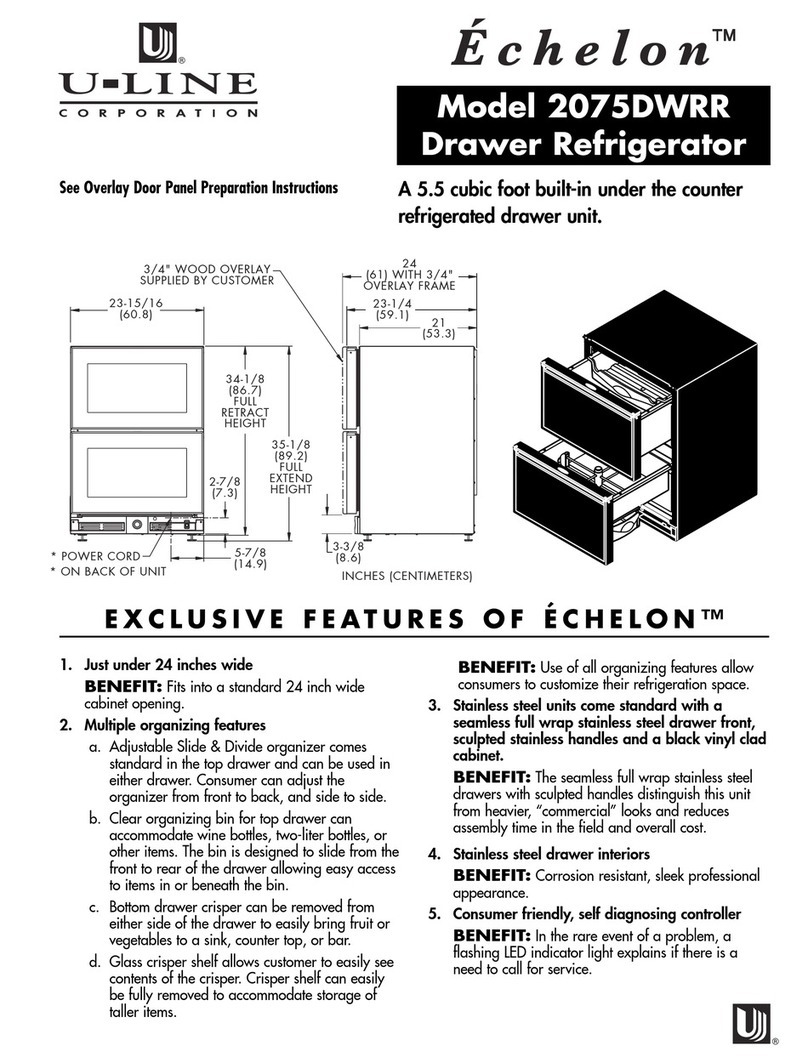
U-Line
U-Line Echelon 2075DWRRSS Specifications
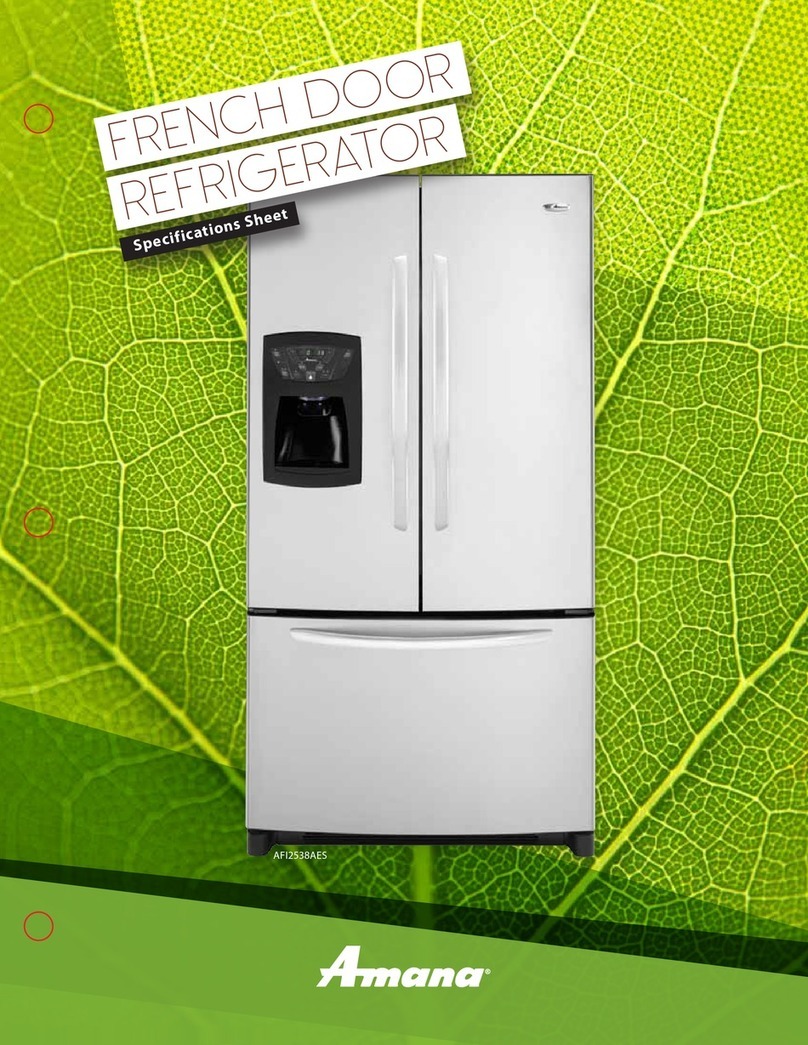
Amana
Amana AFF2534FE AFD2535DE AFI2538AE Specification sheet
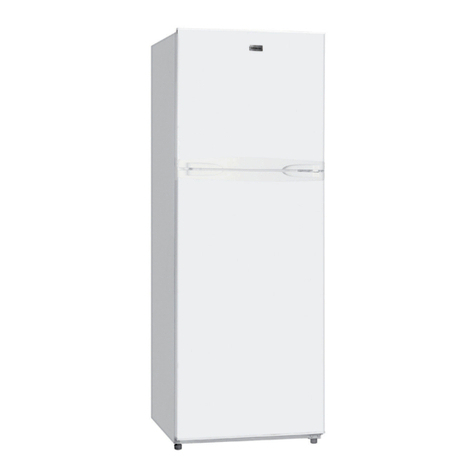
Stirling
Stirling Black Edition STR-H221W instruction manual

Dometic
Dometic REFRIGERATION 10-Series installation manual
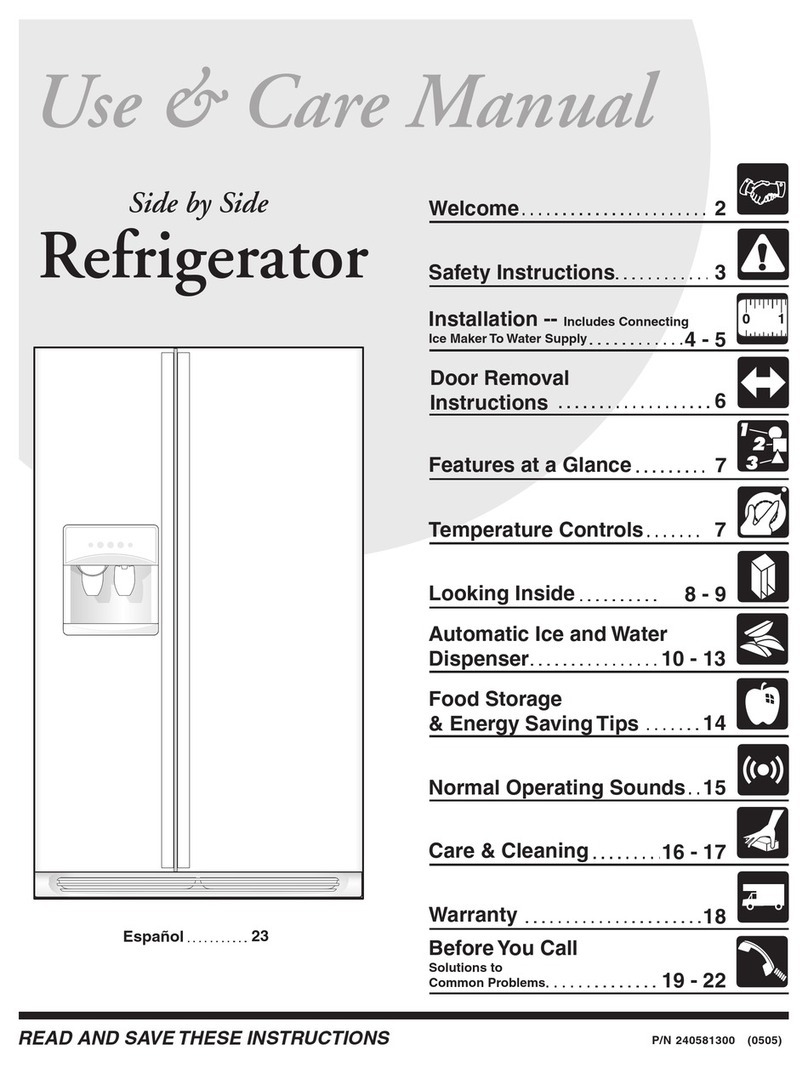
Frigidaire
Frigidaire FRS6R5E use and care manual

Orava
Orava RGO-270 user manual

